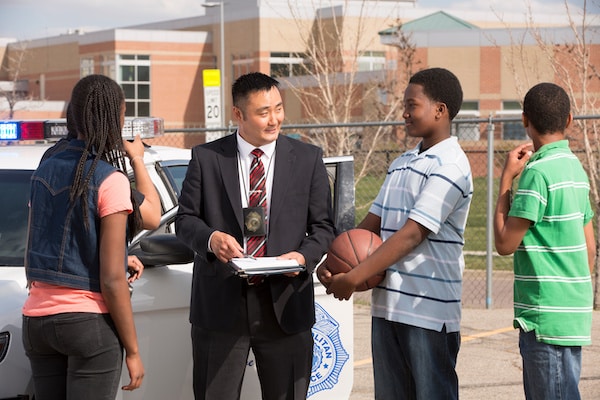ASD Treatments
Treatment and Intervention Services for Autism Spectrum Disorder
With the needs clarified, we propose a schedule to meet the desired behavioral goals, develop customized therapy plans with research-based interventions; and pursue a collaborative, team approach with family, school, and other professionals, building a network of communication and support.
We supervise the implementation of the program and monitor the success of the behavioral interventions to ensure that the program is effective and make modifications as necessary.
We offer a variety of therapies, which are facilitated by highly qualified specialists working in the fields proven to be the most effective at helping individuals with social and language and other developmental issues.
These include:
-
Applied Behavior Analysis
-
Family Coaching
-
Educator Coaching
Your child’s multidisciplinary team will communicate with families regularly to collaborate on progress and come up with strategies and modify programs to address certain delays or concerns. Parental involvement is critical.
Additional Treatment Information
Current treatments for autism spectrum disorder (ASD) seek to reduce symptoms that interfere with daily functioning and quality of life.1 ASD affects each person differently, meaning that people with ASD have unique strengths and challenges and different treatment needs.1 Therefore, treatment plans usually involve multiple professionals and are catered toward the individual.
Treatments can be given in education, health, community, or home settings, or a combination of settings. It is important that providers communicate with each other and the person with ASD and their family to ensure that treatment goals and progress are meeting expectations.
As individuals with ASD exit from high school and grow into adulthood, additional services can help improve health and daily functioning, and facilitate social and community engagement. For some, supports to continue education, complete job training, find employment, and secure housing and transportation may be needed.
Types of Treatments
There are many types of treatments available. These treatments generally can be broken down into the following categories, although some treatments involve more than one approach:
- Behavioral
- Developmental
- Educational
- Social-Relational
- Pharmacological
- Psychological
- Complimentary and Alternative
Behavioral Approaches
Behavioral approaches focus on changing behaviors by understanding what happens before and after the behavior. Behavioral approaches have the most evidence for treating symptoms of ASD. They have become widely accepted among educators and healthcare professionals and are used in many schools and treatment clinics. A notable behavioral treatment for people with ASD is called Applied Behavior Analysis (ABA). ABA encourages desired behaviors and discourages undesired behaviors to improve a variety of skills. Progress is tracked and measured.
Two ABA teaching styles are Discrete Trial Training (DTT) and Pivotal Response Training (PRT).
- DTT uses step-by-step instructions to teach a desired behavior or response. Lessons are broken down into their simplest parts, and desired answers and behaviors are rewarded. Undesired answers and behaviors are ignored.
- PRT takes place in a natural setting rather than clinic setting. The goal of PRT is to improve a few “pivotal skills” that will help the person learn many other skills. One example of a pivotal skill is to initiate communication with others.
Developmental Approaches
Developmental approaches focus on improving specific developmental skills, such as language skills or physical skills, or a broader range of interconnected developmental abilities. Developmental approaches are often combined with behavioral approaches.
The most common developmental therapy for people with ASD is Speech and Language Therapy. Speech and Language Therapy helps to improve the person’s understanding and use of speech and language. Some people with ASD communicate verbally. Others may communicate through the use of signs, gestures, pictures, or an electronic communication device.
Occupational Therapy teaches skills that help the person live as independently as possible. Skills may include dressing, eating, bathing, and relating to people. Occupational therapy can also include:
- Sensory Integration Therapy to help improve responses to sensory input that may be restrictive or overwhelming.
- Physical Therapy can help improve physical skills, such as fine movements of the fingers or larger movements of the trunk and body.
The Early Start Denver Model (ESDM) is a broad developmental approach based on the principles of Applied Behavior Analysis. It is used with children 12-48 months of age. Parents and therapists use play, social exchanges, and shared attention in natural settings to improve language, social, and learning skills.
Educational Approaches
Educational treatments are given in a classroom setting. One type of educational approach is the Treatment and Education of Autistic and Related Communication-Handicapped Children (TEACCH) approach. TEACCH is based on the idea that people with autism thrive on consistency and visual learning. It provides teachers with ways to adjust the classroom structure and improve academic and other outcomes. For example, daily routines can be written or drawn and placed in clear sight. Boundaries can be set around learning stations. Verbal instructions can be complimented with visual instructions or physical demonstrations.
Social-Relational Approaches
Social-relational treatments focus on improving social skills and building emotional bonds. Some social-relational approaches involve parents or peer mentors.
- The Developmental, Individual Differences, Relationship-Based model (also called “Floor time”) encourages parents and therapists to follow the interests of the individual to expand opportunities for communication.
- The Relationship Development Intervention (RDI) model involves activities that increase motivation, interest, and abilities to participate in shared social interactions.
- Social Stories provide simple descriptions of what to expect in a social situation.
- Social Skills Groups provide opportunities for people with ASD to practice social skills in a structured environment.
Pharmacological Approaches
There are no medications that treat the core symptoms of ASD. Some medications treat co-occurring symptoms that can help people with ASD function better. For example, medication might help manage high energy levels, inability to focus, or self-harming behavior, such as head banging or hand biting. Medication can also help manage co-occurring psychological conditions, such as anxiety or depression, in addition to medical conditions such as seizures, sleep problems, or stomach or other gastrointestinal problems.
It is important to work with a doctor who has experience in treating people with ASD when considering the use of medication. This applies to both prescription medication and over-the-counter medication. Individuals, families, and doctors must work together to monitor progress and reactions to be sure that negative side effects of the medication do not outweigh the benefits.
Psychological Approaches
Psychological approaches can help people with ASD cope with anxiety, depression, and other mental health issues. Cognitive-Behavior Therapy (CBT) is one psychological approach that focuses on learning the connections between thoughts, feelings, and behaviors. During CBT, a therapist and the individual work together to identify goals and then change how the person thinks about a situation to change how they react to the situation
Complementary and Alternative Treatments
Some individuals and parents use treatments that do not fit into any of the other categories. These treatments are known as Complementary and Alternative treatments. Complementary and alternative treatments are often used to supplement more traditional approaches. They might include special diets, herbal supplements, chiropractic care, animal therapy, arts therapy, mindfulness, or relaxation therapies. Individuals and families should always talk to their doctor before starting a complementary and alternative treatment.
There may be other treatments available for individuals with ASD. Talk to a doctor or healthcare provider to learn more.
For more information you can visit:
American Academy of Pediatrics Council on Children with Disabilities: https://pediatrics.aappublications.org/content/145/1/e20193447
Autism Society: https://www.autism-society.org/living-with-autism/treatment-options
Autism Speaks: https://www.autismspeaks.org/treatments-autism
Interagency Autism Coordinating Committee: https://iacc.hhs.gov/publications/publications-analysis/2012/treatments.shtml
National Institute on Child Health and Human Development: https://www.nichd.nih.gov/health/topics/autism/conditioninfo/treatments
References
- Hyman, S.L., Levy, S.E., Myers, S.M., & AAP Council on Children with Disabilities, Section on developmental and behavioral pediatrics. (2020). Identification, evaluation, and management of children with autism spectrum disorder. Pediatrics, 145(1), e20193447.
Our Blog
Latest News & Resources

Enhancing Safety and Understanding: Navigating Interactions Between Autism and Law Enforcement
Encounters between individuals with autism and law enforcement can sometimes lead to misunderstandings and distressing experiences. According to the International Board for Credentialing and Continuing Education Standards (IBCCES), individuals with autism are five...

The Impact of Missed ABA Sessions: Strategies to Stay on Course
For families with children on the autism spectrum, Applied Behavior Analysis (ABA) therapy is often a cornerstone of their treatment plan. ABA therapy utilizes evidence-based techniques to improve behaviors and teach new skills crucial for daily life. However,...
Understanding the Autism Treatment Evaluation Checklist (ATEC)
Autism spectrum disorder (ASD) is a developmental disorder characterized by challenges with social interaction, communication, and by restricted and repetitive behavior. Recognizing the need for effective tools to evaluate and measure the effectiveness of autism...
Navigating the Job Market: A Guide for Autistic Individuals in Indiana
Finding a job can be a daunting task for anyone, but for individuals on the autism spectrum, it can present unique challenges and considerations. However, with the right strategies and resources, autistic individuals can successfully navigate the job market in Indiana...
Exploring the Advantages of Center-Based ABA Therapy Versus In-Home ABA
Applied Behavior Analysis (ABA) therapy stands as a cornerstone in the treatment of autism spectrum disorder (ASD) and other developmental disabilities, offering invaluable support to individuals and their families. When considering ABA therapy, families often...
The Power of Play: Benefits of Physical Activity for Children and Young Adults with Autism
Physical activity is a universal need for all individuals, regardless of age or ability. For children and young adults with autism spectrum disorder (ASD), engaging in regular physical activities can bring about a plethora of benefits that extend beyond physical...
Questions about insurance ?
We support our clients with a dedicated insurance team member within our company — that has years of experience in managed care contracting, coding, authorizations and billing issues. We are your advocate and partner in maximizing the potential benefits of your insurance coverage.
